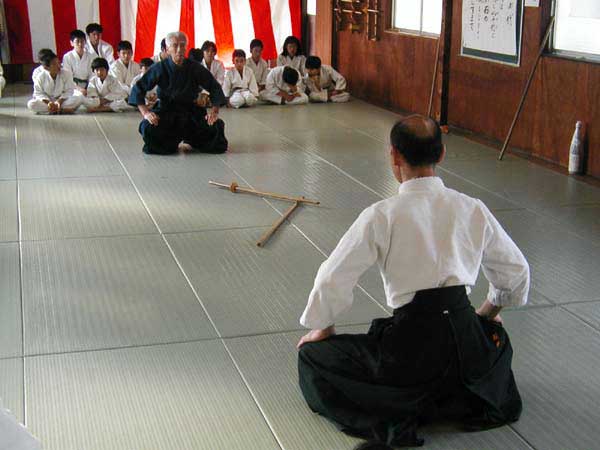Budo is an odd beast at times.
One area where this really shows is in reigi (manner, etiquette). One thing a western student will notice very quickly when entering a dojo is the amount of bowing that goes on. When I started aikido I understood that bowing had to do with respect and when bowing to another person it was explained to me that it was like a handshake. Both parties had made an agreement of respect towards one another. When we bow we are saying, "I respect you and I will look after you as we train."
This worked for me (and still does). But of course we also bowed towards the picture of Morihei Ueshiba, the founder of aikido. To some this seems stranger still. Bowing to the a picture of a dead guy? What? One woman who trained with us for a while came from a Christian background. She made peace with the idea of bowing to "false idols" while in the dojo. However, her husband discovered that this ritual was part of aikido practice and encouraged her to quit. It was unfortunate.
So why do budo students often bow to pictures of people who founded the martial art they practice?
I follow Dan Djurdjevic's blog and his recent post answers this question.
To sum up, he says that it is important to acknowledge your teachers and the knowledge they have given you. Even if you have gone separate ways, you are the martial artist you are now because of your past teachers, and their teachers before them.
In budo, one way past teachers are acknowledged is by having their picture on the shomen (front wall/place of respect). The students bow towards the shomen before and after training. In this way the past teachers continue to be remembered for their contribution to the martial art. This is certainly the case in the aikido, judo and karate dojo I have visited or trained in.
Bowing is based on the Shinto belief system. In Japan people can be found bowing at shrines to show respect to the kami (spirits/gods) that reside there.
Yukiyoshi Takamura (the founder of Takamura-ha Shindo Yoshin Ryu) was a man committed to Shinto ideals and customs. In fact it is considered very important to be familiar with Shinto to understand the mindset and training methodology behind TSYR. Takamura is quoted as saying,
"Acceptance or rejection of proper dojo etiquette can expose a student's dedication or shortcomings to a sensei. The student who refuses to embrace reigi is not suitable for continued training because he ultimately views his own opinions and desires as superior to the aims of the ryu."
So as you can see, he took this very seriously.
This aspect of budo I believe can separate traditional martial arts from the more competitive versions out there. Consider karate, aikido and judo for a moment. Then compare mixed martial arts or kick boxing gyms. Obviously karate and judo have a competitive element to them but reigi is still practiced in these dojo as well.
Some people might say the traditional martial arts allow an individual to develop a sense of humility due to the values of respect that are involved in practice. Whereas, the athletes of mma and boxing, although very proficient physically may not develop as much respect for others. In fact the intense competition of mma and boxing may develop people with very large egos. To be the very best, you have to think you are the very best, don't you?
I would say that the environment of the traditional dojo can be both good and bad. I have seen and heard of examples in a traditional dojo where reigi is used to establish power by either an amoral teacher or senior students. Often passive aggression can be rife in some of these dojo. This is reigi gone bad. It is tainted. Also students come to the dojo with their own values established by their up-bringing. Some students can learn from technically sound "bad people" without being corrupted. Of course, the reverse can occur. A teacher of high morals can attempt to teach and perhaps influence a student with a bad background, but might just end up giving that person more tools to cause harm with.
When all is said and done, reigi requires sincerity. Hollow bows and over-the-top praise for your sempai or sensei looks and sounds nice but is merely acting. Truly respectful students show respect in subtle ways. Sure, they follow the rituals but they are done with intent. They will quietly carry out duties no one else can be bothered with. They will see that the dojo stays clean, they will help a junior when they are struggling and listen carefully to the advice given to them by their seniors.
A student who is sincere in their reigi is open to what is being taught to them and may in time be transformed by their practice. A student that does reigi mere lip-service will not change their ways.
My 10 cents.
Dean.

